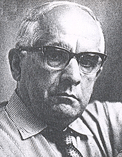The directory «Artists»
Manizer Matvey Genrikhovich
(1891–1966)

Russian sculptor. He studied at the Academy of Arts in St Petersburg (1911-16) under the Russian sculptor Vladimir A. Beklemishev (1861-1920) and G. R. Zaleman (1859-1919). Between 1918 and 1920, while participating in the ‘Monumental Propaganda Plan', he produced the cement relief The Worker (1920-21; Moscow, Petrovsky Arcade). Essentially a social realist, in his style he sought to soften his cold, academic manner with elements of genre and literary narrative and with slight Art Nouveau tendencies of naturalism. In the early 1920s he worked on portrait figures of Lenin, and he produced many monuments of him, which were erected in various towns in the USSR. The most notable is that at Lenin's birthplace of Ulyanov (now Simbirsk), on the high bank of the Volga (bronze and granite, 1940). The scrupulous style of his modelling became more generalized here, accentuated by the dynamic turn of the figure in space. He sculpted a series of monuments to the poet Taras Shevchenko that were erected in the Ukraine, the most famous being the monument in Kharkiv (granite and bronze, 1935), executed with Iosif Langbard, in which the heroes of Shevchenko's works are represented alongside the figure of the poet himself in a spiral-like composition; among them stands out the figure of the farmworker Katerina with her child, which Manizer recreated as an independent work in plaster (1935; Moscow, Tret'yakov Gal.). He also created a figure of the young heroine of World War II Zoya Kosmodem'yanskaya (bronze, 1942; Moscow, Tret'yakov Gal.). The free-standing statue depicts the partisan setting out on a military operation and became the basis for the monument erected in her home town of Tambov in 1947. Manizer was also responsible for the sculptures installed at Moscow Metro underground stations, such as those at Revolution Square (1938) and Izmaylovskaya (1944). The bronze statues at Revolution Square station are particularly interesting as they fully embody the aesthetic of social realism.
USSR, 1959,  Bazhov's monument in Sverdlovsk
Bazhov's monument in Sverdlovsk
USSR, 1970,  Bazhov's monument in Sverdlovsk
Bazhov's monument in Sverdlovsk